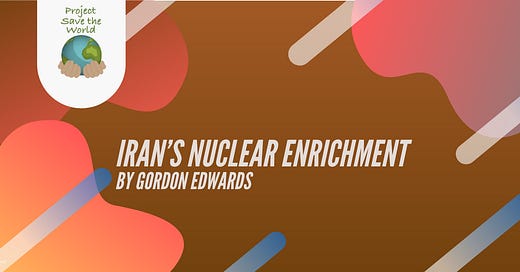Iran's Nuclear Enrichment
By Gordon Edwards, Ph.D., President, Canadian Coalition for Nuclear Responsibility; Board of Directors, Project Save the World
There is a lot of confusion about uranium enrichment in Iran.
In natural uranium, only 7 atoms out of 1000 are chain-reacting uranium-235. The other 993 atoms are, for the most part, uranium-238 atoms – not a chain-reacting material.
Uranium enrichment refers to any technology that increases the percentage of the chain-reacting U-235 beyond the 0.7% level (i.e. natural uranium). But there is a good deal of misinformation and/or misunderstanding about enriched uranium in the media recently.
Nuclear Explosions
It is often reported that 90% uranium enrichment is “needed” to have a nuclear weapon. This is not true. The Hiroshima bombs had only 80% enrichment. Iran has a good deal of 60% enriched uranium, and you can make a bomb from 60% enriched uranium -- it would be bulkier than a bomb with 90% enrichment and therefore harder to deliver, but not so very much harder.
Also, the mechanism needed for making a uranium bomb is very much easier than what is needed for a plutonium bomb. It can be done with a lot less effort and taking very little time. It’s called a “gun-type” atomic bomb rather than an “implosion-type” atomic bomb.
Gordon Edwards
The gun-type bomb just fires one chunk of uranium into another chunk (the target) so that the two chunks add up to more than a “critical mass”. It is so simple it cannot possibly fail – as a result they never had to test this type of bomb before using it. They dropped it on the city of Hiroshima with no testing. There is a need for a precision timed “neutron source” but that is very old technology that has been well known for ages.
The implosion-type bomb is much more sophisticated, requiring a perfectly spherical
Keep reading with a 7-day free trial
Subscribe to Project Save the World's Substack to keep reading this post and get 7 days of free access to the full post archives.





